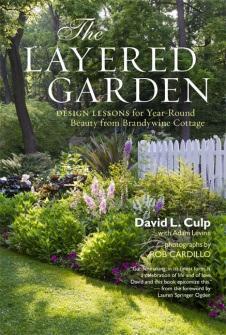
If you are a fan of Christopher Lloyd and Fergus Garrett, as I am, then you will enjoy The Layered Garden by David Culp. The title attracted me as I am interested in the notion of successional planting so I asked Timberpress for a copy as one of my review books. I wasn’t disappointed and I have thoroughly enjoyed reading it.
David is an American garden designer and probably well-known across the pond but I had never heard of him. The book is based on his own garden in Pennsylvania where he has created a garden over 20 years. David is a huge fan of Lloyd as well as Gertrude Jekyll, Beth Chatto, Graham Stuart Thomas and there is an obvious English Garden influence in the photographs of his garden. The premise of the book is how David Culp has used plants to create a layered garden, much like Lloyd’s successional planting. Like me he is a plantaholic and has worked hard to create a coherent and beautiful garden in which to grow his treasurers. As he says in the Introduction
“The collector in me thinks each individual specimen is beautiful, … otherwise I would not bother growing them. But the designer in me wants more than a botanical garden with each genus grown in its separate bed. Plants are the basis of my garden artistry; serving as pieces in a design puzzle, as colours in a palette, as elements in a sculpture. As with artists in any medium, the more we learn about these vehicles for our expression and the more passionate we are about them, the more ways we will find to use them and the more beautiful our gardens will become.”
At this point I was hooked. I have often thought that there must be a way to create a beautiful garden full of interesting and assorted plants but I have struggled to work out what it was. Another aside that made me smile was Culp’s comment that the trend in his part of the US was to have gardens which were only of interest from March through to September and whilst he, like any gardener, enjoyed looking at seed catalogues etc over the winter he really didn’t want to do this for 5 months. I totally agree – a year round garden is what I am trying to achieve.
The book takes you on a tour of the garden and its various areas and why and how they have been created, their seasons of interest, the layers and what the star performers etc. His approach is to have borders/beds that peak at different times of the year but that also have layers of lesser interest through the rest of the year. I have started to try this approach in my garden and whilst it isn’t that hard to have a peak season of interest in a bed, I am finding it harder to make the borders seem interesting for the rest of the year but this book has helped to open my mind to new ideas and approaches using bulbs, annuals, pots and in particular looking at foliage rather than relying on flowers. It is a higher maintenance approach, again like Lloyd, but I think it may be the way forward for me.
Throughout the book there are special small sections looking at different elements of design and plants for specific area. I particularly liked the one on color in the garden. Culp recalls a visit from Lloyd to his garden and a conversation about color. As we all know Lloyd is renowned for using clashing and bright colours; Culp feeling a little argumentative challenged his approach. He argued that instead of having colours of the same value, as Lloyd insisted, that they should instead be of different values which would provide depth and contrast. He describes the encounter like arguing with the Pope which made me laugh – as to Lloyd’s response to the challenge, “Suffice it to say, he was unconvinced.”
Having toured his garden he then looks at particular groups of plants that he considers the stars of his garden and these are arranged through the seasons. I could tell David was a gardener after my own heart from a quick initial flick through this section as all my favourites are featured: Peonies, Roses, Lilies, Iris, Asters, Hydrangeas, Alliums, Hellebores, Narcissus and Snowdrops. He talks about how to grow the plants, what works for him, how he propagates and maintains them. The Layered Garden, like many I have enjoyed recently from Timberpress, has that feeling of having a really good chat with a fellow enthusiastic gardener. Whilst the book is informative on plants, design, horticulture it also has short anecdotes scattered throughout it which makes the book more personal and engaging.
Throughout the book is illustrated with beautiful photographs of the garden and close-ups of the plants taken by Rob Cardillo. I found the book great to flick through but also a very good read from start to finish. I believe in balanced reviews but I cannot find any fault with The Layered Garden at all, it is my personal ideal gardening book – in fact I think it is my book of 2012.
I will leave you with a quote from the Epilogue,
“Many gardeners have a stilted definition of beauty, having been lectured at too often about what we are supposed to find beautiful. But I am an equal-opportunity seeker of the sublime, grateful to appreciate it wherever I find it.”

